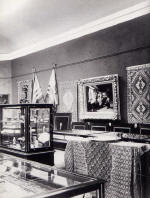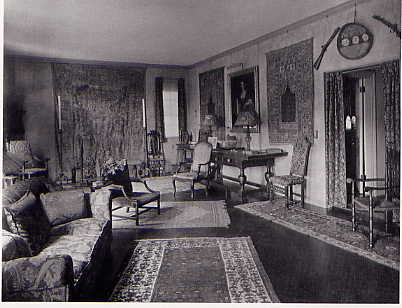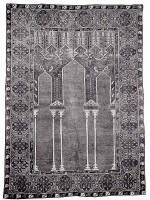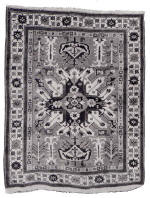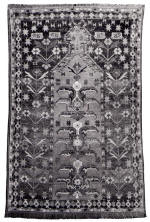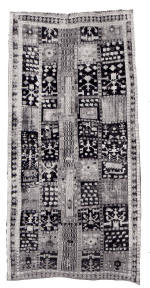|
Early
Rug Collectors by Julia Bailey This essay was originally published in Through the Collector’s Eye, Oriental Rugs from New England Private Collections. |
|||||||||
|
|
In 1741, Isaac Royall, the young and handsome son of a rich merchant, posed for a portrait with his wife, sisters, and baby daughter. The artist, Robert Feke, painted them with just one of their possessions, a bold "Transylvanian" carpet covering the table around which they were gathered.1 As much as the velvet and satin they wore, the rug proclaimed their prosperity. It documented the presence and prestige of oriental rugs in 18th-century New England. But neither it nor any other rugs Isaac Royall may have had in his stately house in Medford, Massachusetts, were the property of a collector. Royall, if he talked about his rug at all, referred to it as a "Turkey carpet," the same thing he would have called an exotically patterned rug made in England or France. 2 Until the late 19th century, rug collecting—that is, not just having rugs for show but gathering them knowledgeably—was nonexistent. A new appreciation of rugs, involving study and classification as well as glorification, came about partly as a result of the Industrial Revolution. The South Kensington Museum in London—now the Victoria and Albert—was founded to improve industrial design by making "fine examples of ornamental art" accessible to students, manufacturers, and the public.3 Rugs were included; the first, bought in 1876, were all modern but were soon supplemented by older ones. At the same time, Continental museums of both applied and fine arts were also building up their rug holdings. In 1891, a mammoth exhibition of carpets drawn from Austrian royal treasuries and various dealers took place at the imperial Austrian Trade Museum in Vienna. Two years later, the South Kensington Museum bought the ballyhooed Ardabil carpet. The airing of so many splendid old rugs generated a number of scholarly treatises and deluxe picture books and awakened public interest on both sides of the Atlantic. Wealthy Americans, such as Chicago streetcar baron Charles Yerkes and Philadelphians Charles and Mary Lees Williams, heirs of an American carpet firm, hurried to accumulate great rugs of their own.4 In New England, rug collecting began at this time but on a more modest scale. With one exception, the collectors profiled here sought recently made rugs or contented them selves for the most part with fragments of old ones. While they were not the only area residents to collect rugs, they or their heirs established relationships with New England museums—as founders, builders, lenders, or donors. Consequently, their stories—who they were, what they bought and where, what they did with their rugs, and how museums responded to and were changed by their generosity—can be reconstructed .5 The senior New England collector, George Walter Vincent Smith (1832-1923), was born in Derby, Connecticut. He first worked for a New York fabric importing firm and then with a partner bought out a failed carriage building business; revived and renamed Stivers and Smith, it made Smith a fortune on which he could retire at age 35. After two years in Europe, he married Belle Townsley, a native of Springfield, and moved to that western Massachusetts city, where he devoted the rest of his life to acquiring an eclectic assortment of Italian paintings, American paintings and drawings, European and Far Eastern textiles and furniture, Oriental arms and armor, cloisonné, ceramics, lacquerware, metalwork, ivories, and carpets. In 1889, the Smiths offered to lend and eventually give this collection to Springfield if the city would construct a museum suitable to house it. The resulting yellow Italianate building, opened in 1895, became the repository of the 6,000 objects, including 146 rugs, that Smith—who was the rug enthusiast of the couple—had amassed during his lifetime. The collector himself oversaw the design of the museum, helped choose the display units, and installed the galleries. In his and Belle's full-to-bursting house nearby (frontispiece), Smith had put most of his rugs on the floors. In the museum they were displayed in every possible way—on floors and tables, in cases as backdrops for objects, and on gallery walls (fig. 1).6 Smith may have bought his first rugs during his travels with Belle to London and Florence in the 1880s, but he subsequently made all rug purchases close to home. In the years 1892 and 1897-1898, he acquired more than 100, singly or up to 19 at a time, from dealers in Boston, New York, and Springfield. He bought his last rug in 1905. Receipts for most of these transactions are preserved in the George Walter Vincent Smith Museum archives; a typical purchase, "bought of S.A. Keuleyan, Importer of Choice Oriental Carpets, Rugs, Portiers, Embroideries, Etc., 212 Boylston Street and Park Square [Boston], November 7th, 1893," included 14 rugs and two embroideries for a total of $350.7 Another of his favorite rug sources was the Springfield rug firm, Bedros H. Markarian & Co. (now Markarian & Markarian). In only a few cases can bills of sale, with their inadequate descriptions ("Boukara, $10.00; Anatolian mat, $8.00," etc.), be matched to specific rugs in the collection; for instance, a long and very hand some Talish runner8 cost Smith $37 in 1897, whereas he was willing to pay relatively high prices- $400, $800 and $1,500—for three silk Tabriz rugs. Smith ordered all his personal correspondence destroyed after his death, but his rugs themselves testify to his taste for wide variety and recent make. He bought many rugs new (but mostly free of industrial dyes) and others with several decades of wear. His 55 Persian examples included the three silk Tabriz rugs and many other finely woven commercial pieces, as well as some village or tribal specimens, such as a Senneh saddle rug, a "folkish" Bijar sampler, and several Kurdish bags. The 35 Turkmen rugs from various tribes ranged from main carpets to bags, tentbands, door surrounds, and wedding trappings. There were 31 Caucasian rugs from most of the weaving districts, including six sumak rugs. The 16 Turkish representatives included three elegant Kula or Gördes prayer rugs, two decidedly naive village variants of coupled-column prayer rugs, and other village rugs, kilims, and pillow covers. The nine Chinese pieces were small mats.9 Smith served as curator of his collection until his death at 91; Belle succeeded him until she died in 1928. Their museum, on the City Library Quadrangle in Springfield, is still open to the public. The galleries they oversaw have been updated but retain an appropriately idiosyncratic, late-Victorian air—and always display rugs from the collection. A second great New England collector, Denman Waldo Ross (1853-1935), surpassed Smith both in his buying and his chronicling; he bequeathed to Harvard nearly 70 years' worth of travel diaries, letters, and sketchbooks. Ross's well-to-do Cincinnati family sent him off to Harvard to become a gentleman and a scholar. After he earned a Ph.D. in economics, he turned professionally to the study of art, becoming a proficient painter himself along the way. In 1899, Ross was appointed Special Lecturer on Design in the Architecture School at Harvard, and in 1909, he joined the Fine Arts faculty there. He published three books that strove to articulate the principles of order underlying great design in all the arts.10 Although they influenced subsequent art theorists, these works were too abstruse to have much popular impact, and today the scholar's material legacy has eclipsed his theoretical one. Whenever Ross was not teaching (and he kept his teaching schedule light), he traveled. His diaries record trips to Europe, India, China, Japan, Ceylon, Burma, Egypt, Mexico, and Central and South America. Everywhere he went he collected art—paintings, prints, drawings, ceramics, and textiles—to inspire and illustrate his theories about design. He acquired little for his own house in Cambridge; his purchases went mainly to the Museum of Fine Arts in Boston or, to a lesser extent, the Fogg Art Museum of Harvard University and the Museum of Art at Rhode Island School of Design. Over the course of 40 years he gave the MFA about 11,000 items, including 4,000 textiles, many of which came from Egypt, Peru, the Mediterranean, and Java. The 82 rugs or, more significantly, pieces of rugs that Ross selected for the MFA in Boston would help steer future carpet acquisition by that institution toward antique and "court" specimens.11 In 1893, the M FA had already received a famous antique carpet, a small pictorial Mughal rug that had belonged to Boston capitalist Frederick L. Ames. Between 1895 and 1926, Ross contributed 41 fragments, most of them from "classical" carpets woven on the court or commercial looms of Safavid Iran and Mughal India. Among 11 Indian fragments was a tiny, velvety piece with scrolling-stemmed lilies, from a Shah Jahan-period wool rug of astounding fineness—more than 1,750 knots per square inch. Another was a more substantial section, one of 15 extant, of a once vast carpet with a huge scrollwork of beasts disgorging other beasts. The 24 Persian fragments included a cartouche from the main border of one of the Ardabil carpets, two pieces of a Northwest Persian medallion carpet, a tiny "Sanguszko" border fragment depicting an animal combat (three larger pieces of the same rug are in the Textile Museum in Washington), and fragments from several different "vase" carpets. Of the 41 whole carpets Ross donated, one was an unusually colorful silk-pile-and metal-thread "Polonaise" rug from 17th-century Iran. The rest were later Chinese, Turkish, Caucasian, Turkmen, and Persian rugs including, in baffling disproportion, 18 Senneh kilims. Ross bought many of his textiles at their place of origin, but his travels completely bypassed the Middle East. Museum records, although spotty on the matter, seem to indicate that his primary supplier of rugs was the dealer Dikran G. Kelekian of New York and Paris,12 and that he made single purchases from a few other sources; one fragment, for instance, came from fellow Harvard alumnus, dealer, and author, Arthur Urbane Dilley, and another—a substantial fraction of a handsome "vase" carpet—from Countess Elizabeth Phelps Resse of Anzio, Italy. Most of the rugs and fragments Ross collected have representational elements—flowers, vegetation, or sometimes animals—not standing on their own, as "pictures," but as components of rhythmic patterns (referred to in Islamic art as "arabesque"). This is as true of the collector's Caucasian rugs, which have overall floral or palmette designs, as it is of his old Persian and Indian fragments. It mattered little to Ross whether a rug he bought was new or old, intact or a scrap, as long as it embodied what he termed "Pure Design": a formal order of line and color that he attempted to define, teach, and make the basis of his own painting. Although Ross's rug collection had more theoretical underpinnings than others in New England, it was not the only one assembled for didactic purposes, nor the only one to include fragments. His contemporary, Eliza Greene Metcalf Radeke (1854-1931), was one of the first great supporters of Rhode Island School of Design and served as its president from 1913 to 1918. She was born in Atlanta, Georgia, where her father was a cotton agent (he later took up wool manufacturing in Rhode Island), and earned a degree at Vassar. With her mother, she raised the money to found R ISD in 1877, and throughout their lives she and her brothers (one of whom became a U.S. Senator) donated funds to expand the school. She married a collector, Gustav Radeke, in 1880 and began to assemble objects for the museum at RISD. After her husband's death in 1892, she continued to buy and donate prints and drawings, American furniture, ceramics, and textiles—hundreds of examples, including Italian vestments, Greek Island embroideries, Kashmir shawls, and Japanese brocaded fabrics. Despite her avid textile buying, Mrs. Radeke would not have considered herself a rug collector; she apparently never bought intact rugs, either for the museum or her own house. Nevertheless, the 13 fragments that she donated to the museum between 1911 and 1912 form the "classical" core of its carpet collection. There is no record of where she bought them, although her search for other textiles took her to Florence, Athens, and Berlin. It is certain that she never traveled to the Middle East. Unlike Ross, Mrs. Radeke admired the geometric patterns of early Turkish rugs. One of her fragments was a long side section of a "small-pattern Holbein," showing its "kufesque" border and a row of octagons. She also gave half of an Ushak prayer rug (cat. no. 1), a 10-foot-long strip of a medallion Ushak carpet, and a part of a "Transylvanian" rug with a star and-cartouche border (cat. no. 2) to the RISD Museum. Other fragments included part of a side border from an early Caucasian floral carpet, a corner of a Northwest Persian medallion carpet, pieces of two "vase" carpets (cat. no. 32), part of the border of a 17th-century Mughal carpet, and a "Salting" carpet fragment probably made in 19th-century Hereke, which Mrs. Radeke had bought as 16th-century Persian. During the 1950s, in a "deaccession" now lamented by its curators, the RISD Museum sold a Persian fragment and traded away (to the Textile Museum) Mrs. Radeke's chunk of a "para-Mamluk" carpet. Like the RISD Museum, the Fogg Art Museum of Harvard University considers itself a teaching institution. Its primary emphasis, however, has long been the history of European fine arts; it acquired its best 19th-century rugs somewhat reluctantly and relatively late. They had been assembled by a Cambridge resident, Willoughby H. Stuart, Jr. (1874-1948), the grandson of New Hampshire granite magnate and philanthropist Arioch Wentworth. Stuart spent his adult life managing his inheritance and filling his houses—the first in Swampscott, Massachusetts, and after 1924, a 33-room mansion in Cambridge, plus a summer home on a Maine island—with antique furniture and paintings, ship prints, pistols, American Indian artifacts, books, European tapestries, and rugs. Although as a boy Stuart had spent winters with family in England and had traveled around the world, he collected locally. Most of his rugs came from dealers in the Boston suburb of Brookline, although he purchased his Chinese pieces from Yamanaka, a prominent Kyoto art firm with a branch office then conveniently located in the family-owned Stuart building in Boston. By 1920 he had concluded his rug buying. Stuart's collection consisted mainly of small rugs, only one of which (a worn "Indo-Persian"), predated the late 18th century. Of 12 Turkish rugs, all except one were prayer rugs, and seven of these were from Gördes or Kula. Other weaving areas ere evenly represented: the eight Persian rugs included a fine Ferahan and a Senneh kilim as well as one large Qashqai rug and Kurdish and Southwest Persian bag-faces. The eastern Caucasus was the source of eight rugs, including several runners and an outstandingly fine, silk-wefted Shirvan "Marasali" prayer rug. There were eight Turkmen pieces—including Yomut and Tekke main carpets, two Ersari engsi, and Tekke bagfaces—and five Chinese rugs in various sizes and shapes. Stuart prized his rugs. His daughter, Elizabeth Gowing, remembers that he cautioned his four children not to walk on an Isfahan carpet, and that when the Cambridge house was closed each summer, he refused to let paid help touch any of the rugs and instead drafted family members to haul them to a cedar-lined closet in the attic. Photographs of the downstairs rooms, entrance hall, and staircase of his house show the pieces Stuart reserved for the walls: the aged Indo-Isfahan, the Chinese pillar rugs, and particularly the Kula and Gördes prayer rugs, two of which flanked his prized Godfrey Kneller portrait (fig. 2).
When Stuart died his family divided the rugs, but most of them were reassembled in the 1960s by Mrs. Gowing, who first offered to lend them to the MFA in Boston. Occupied with the quest for antiques, the textile curator there could not find the time to inspect them. They were lent instead to the Fogg, which had recently put on a successful exhibition of Turkmen rugs (see below). In 1977, the young and very enthusiastic Honorary Curator of Rugs, Walter B. Denny, helped convince Mrs. Gowing to give 33 of them to the museum. But when they were offered, the President and Fellows of Harvard College, who must approve all significant museum acquisitions, questioned the value of "village and nomadic" rugs to the mission of the University. The Director of the Fogg polled several academic experts for their opinion on the matter. One professor replied that he did not see much value in accepting the rugs, since there was n0 instruction offered about them, no proper storage for them, and that "the collection would be used primarily for ladies' clubs.13 A curator disagreed, seeing in the Stuart collection "a distinguished assemblage... representative of exciting and crucial levels of Islamic culture" that, while comparatively recent, contained "elements of design that can be traced back to ancient times." He concluded, "We would be foolish not to accept their splendid gift.14 The Corporation ultimately did accept the gift, although the process brought to the fore the continuing skepticism of the academic world about the worth of later rugs for study and the value of rug studies themselves. Several exhibitions of the Stuart rugs followed in the Fogg courtyard, and Denny published seven of them in his book, Oriental Rugs.15 For its 1980 show, Turkmen, the Textile Museum borrowed the Yomut main carpet.16 By 1982, Mrs. Gowing and her sister-in-law, Mrs. Harborne W Stuart, had added eight more Stuart rugs to the original gift. When the Arthur M. Sackler Museum at Harvard was opened in 1985, all the rugs in the Fogg were transferred to climatized storage space in the new building. The New Englanders considered thus far filled their houses or chosen museums with miscellaneous collections of which rugs were just a small part. But the enterprise of collecting only rugs also existed in New England in the early part of the 20th century. A photograph-filled binder found in the basement of the Harvard Fine Arts Library in the Fogg offers a surviving pictorial record of one such endeavor. The typescript title page of the album reads, "A Collection of Eastern Carpets Assembled 1906-1930 by Charles O. Richardson and Ralph Woodworth." Charles Richardson (1871-1963) was born in Boston of an impoverished branch of an illustrious family that included the architect Henry Hobson Richardson. Too poor to attend Harvard, Charles went to work for Wellington, Sears and Co., a Boston maker of industrial textiles, and eventually became clerk (i.e. treasurer) of the corporation. He married the stepdaughter of Ralph Woodworth (1868-1949). Woodworth, born in Tomales, California, had gone to Harvard for his undergraduate and law degrees and had a private law practice in Boston. Although Woodworth bought enough rugs to furnish his own house, Richardson was the enthusiastic collector. His daughter (and Woodworth's granddaughter) Mabel remembers that her father purchased some of his rugs in the Turkish port of Izmir while he was on business trips, but that he more often bought them from local merchants, in particular Moustapha Avigdor, the late Brookline dealer who was near-legendary in the Boston area for his fine old pieces. Richardson spent hours in the dealer's shop and on occasion invited Avigdor to the family's big house in Weston, Massachusetts, where he could view the collection—most of it displayed on the floor, although some of the bagfaces covered chair backs, and the best rugs were stored in cedar chests in the attic. With a few significant exceptions, Richardson's rugs dated from the late 18th or 19th century. His favorites were Turkish; out of 39 Anatolian rugs, 25 were prayer rugs and three were prayer kilims. The collector clearly preferred rugs that celebrated their Ottoman court lineage: eight prayer rugs from Kula, five from Gördes, and five from Lâdik. There were five older Turkish pieces: two coupled-column rugs (fig. 3), one Ottoman-style Cairene rug and a fragment of a second, and an intact "Lotto."
The 31 Caucasian rugs came predominantly from the eastern Caucasus but also included Kazak and Karabagh pieces, notably a resplendent "sunburst" rug in apparently pristine condition (fig. 4). The 26 Turkmen examples included Yomut and Saryk main carpets, Tekke, Yomut, and Chodor bagfaces, a Saryk door surround, and two striking Ersari "Beshir" prayer rugs (fig. 5). Among the 18 Persian rugs, which were mostly workshop products of Arak and included no tribal weaving whatsoever, were one intact 17th-century "Indo-Persian" and a fragment of a second, and an amusingly naive variant of a Northwest Persian garden carpet (fig. 6).
In 1928 Richardson lent some of his collection to the MFA in Boston for exhibition. He may have considered donating the entire collection eventually, but the Great Depression put an end to any such notion. In 1932, the rugs were auctioned off at the American Art Association/Anderson Galleries, Inc. in New York City.17 Although the auction dispersed his son in-law's collection, it did not extinguish Ralph Woodworth's fascination with rugs. He spent his last years writing a treatise on them18 —a "huge manuscript," according to his granddaughter—for which he vainly sought a publisher. Sometime after his death the book disappeared. Some of the rugs in the collection, however, have resurfaced in private hands and museums. One of the Gördes prayer rugs is in a collection in Bloomfield, Connecticut, while the Persian garden carpet has found its way into a large collection in Seattle, Washington, reportedly having come from a house on Long Island by way of a Madison Avenue antiques dealer. The Ottoman Cairene fragment belongs to the Textile Museum, which also owns another piece of the same rug.19 One of the coupled-column rugs is now in the Metropolitan Museum of Art, the gift of a renowned collector. By 1943 it had made its way back to the Boston area (reportedly to the shop of Moustapha Avigdor) and was priced at a scandalous $1,500 (having sold at the 1932 auction for $390). The renowned collector had spotted it and lamented to his fiancee that if he tried to buy it, the dealer would not lower the price. But the fiancee had a savvy woman friend convince the dealer to sell it for about half what he had been asking. It was laid out on the floor as a surprise for Joseph V McMullan when he carried his bride Connie over the threshold.20 Joseph V. McMullan (1896-1973), who assembled one of the greatest private collections of rugs in he world, was born in the Bronx and lived primarily in New York City; a New Englander he was not. New England—in particular, the Boston area—nevertheless supplied him with a number of his rugs and benefited enormously from his generosity. McMullan's "biography"—in the form of his own reminiscences and those of friends and fellow rug collectors—tells at length how he went into engineering directly out of high school, working his way up to a vice presidency of Naylor Pipe Company of Chicago, for which he helped design a portable pipeline used by the Allies in North Africa during World War II.21 He bought his first rug—on sale at Gimbel's—for his family's house. It was of poor quality and wore out quickly. After this unsuccessful purchase, he began o frequent the New York Public Library for information and the American Art Association auction galleries for a constantly changing display of older carpets, some of which he was soon bidding on. McMullan joined the now-famous rug society, the Hajji Baba Club, in 1933, the year after its formation. Although he bought many of his rugs in New York, McMullan was on occasion a formidable presence in Boston, where he and his wife owned a second house, and where he often attended auctions, to the dismay of the rug dealers he consistently outbid.22 As McMullan's sumptuous publication of his collection reveals,23 he bought both classical rugs—from fragments to palace-sized carpets—and village and tribal pieces in powerful and unusual designs that he approvingly called "rough-and-tumble."24 The first exhibition of these rugs—and the first rug exhibition ever at Harvard—was held in 1949 in the Fogg Art Museum, an institution McMullan actively supported. To further the study of Islamic art at Harvard, he endowed the Damon-Dilley fund, named for two fellow Hajji Baba Club members. When the budding Turkmen rug enthusiast Christopher Dunham Reed pro posed that the Fogg mount a modest exhibition of carpets, McMullan stepped in with funding for a catalogue and supplemented Boston-area rugs with others recruited from the Hajji Babas. The 1966 exhibition, Turkoman Rugs, was a groundbreaking endeavor that drew an enthusiastic public.25 McMullan's final project was his catalogue, issued in 1971, of a selection of rugs in the George Walter Vincent Smith Museum. The Metropolitan Museum received by far the largest share of McMullan's collection.26 But he gave the Fogg the four great "classical" carpets that the museum owns, as well as one unusual Caucasian medallion rug.27 Born at the end of the 19th century, McMullan was the last of those who defined rug collecting in New England. Unlike him, most of his predecessors were gatherers of a wide variety of fine and decorative arts. But while they might buy their paintings in Europe or their batiks in Java, they, like McMullan, found most of their rugs close to home—usually from favorite dealers who had roots in the Middle East and could be their advisors and fellow enthusiasts at a time when there were fewer rug books and rug collectors. Most of these museum benefactors were wealthy from birth, marriage, or early business success and could spend as much time as they wished hunting for things to collect. Some acquired rugs without the need to possess them and transferred them directly to museums; others bought for the pleasure of having their rugs close at hand. One sought rugs that best illustrated his written theories about the formal elements of good design; another acquired them to help the students of her institution become designers themselves. Early rug collecting has sometimes been characterized as the rapid snapping-up, after the great Vienna exhibition of 1891, of all the large and lavish "classical" carpets, followed by a frenzy for Gördes prayer rugs, the hungry collector's substitute for "court art." The New England collectors profiled here did indeed buy their share of the pallid and elegant Anatolian prayer rugs promoted by Tiffany Studios and other New York dealers, and sometimes they elevated these rugs to special prominence on their walls. But for these New Englanders, such rugs always were rivaled by others with a pronounced folk character; nearly everyone, for instance, accumulated Turkmen bags. Joseph McMullan is often credited with innovative collecting because he bought both antique court rugs and newer village and tribal pieces, yet to a more modest degree, Ross and Richardson had practiced the same eclecticism before McMullan. Nor is the collecting of fragments a recent development; in the second decade of the century, both Radeke and Ross were seeking out battered old wrecks. Specialized collecting by geographic area or cultural group, however, had yet to develop in New England;28 everyone had rugs from several areas, and Smith, Stuart, and Richardson seemingly tried to be comprehensive. While Turkmen rugs, bags, and other tribal articles were surprisingly abundant, there was a paucity of Persian tribal goods, and—with the exception of Ross's lot of Sennehs—of kilims from anywhere. Caucasian rugs, in terms of number, were as popular as Turkish. Chinese rugs were the least collected. It may prove surprising how much the present exhibition—boasting recently acquired rugs of thoroughly modern collectors—has in common with the New England collections of the past. Banished now are the products of Persian city workshops and the Gördes and Kula prayer rugs, and in their places are more rustic, robust, and whenever possible, atypical substitutes, including bags and bagfaces. But the affection of New England collectors for Caucasian and Turkish village rugs, their hesitancy toward kilims, their limited enthusiasm for rugs from China, their fascination with Turkmen weaving, and their pursuit of antique fragments all have roots nearly a century old. JB 1. The painting, owned by Harvard University, hangs in Langdell Hall, Harvard Law School. It is reproduced in numerous studies of American painting, and in Maurice S. Dimand and Jean Mailey, Oriental Rugs in the Metropolitan Museum of Art, New York, Metropolitan Museum of Art, 1973, fig. 178, p. 193; also in Nina Fletcher Little, Floor Coverings in New England Before 1850, Sturbridge, Massachusetts, Old Sturbridge Village, 1967, fig. 2, p. 40. 2. Little, pp. 6-9. 3. See David Sylvester, "On Western attitudes to Eastern carpets," Islamic Carpets from the Joseph V. McMullan Collection, London, Arts Council of Great Britain, 1972, pp. 6-7. 4. See John Kimberly Mumford, The Yerkes Collections of Oriental Carpets, New York, Knapp Company, 1910 (the Metropolitan Museum of Art bought many of these rugs; others are in the Textile Museum and the Brooklyn Museum), and Charles Grant Ellis, Oriental Carpets in the Philadelphia Museum of Art, Philadelphia, Philadelphia Museum of Art, 1988, for the Williams Collection, now in that museum. 5. Sleuthing was required, however, and Walter B. Denny, Charles Grant Ellis, Deborah Kraak, Karen Papineau, András Riedlmayer, Louann Skorupa and Jeff Spurr were valued co-detectives. 6. The biographical information here is summarized from an unpublished museum handout by Karen Papineau, Assistant Curator of the George Walter Vincent Smith Museum, who also made archival information and photographs available. 7. Smith apparently patronized this newly emigrated Armenian immediately upon Keuleyan's arrival in Boston. (See Russell Fling, "Early Armenian Rug Merchants in the United States," Oriental Rug Review, 10, no. 4 [April/ May 1990], p. 37.) According to other receipts, Keuleyan had moved by 1897 to a downtown Broadway location in New York, where Smith continued to visit him, and also supplied rugs to Charles Hall, Inc., a Springfield furniture business where Smith bought many more. 8. Not illustrated in the catalogue of Smith's rugs (see note 9), but reproduced by Sheila S. Blair and Jonathan Bloom, eds., Images of Paradise in Islamic Art, Hanover, New Hampshire, Dartmouth College, Hood Museum, I991, no. 24, p. 90. 9. Seventy-five of Smith's rugs were catalogued in 1971 by Joseph V. McMullan. See The George Walter Vincent and Belle Townsley Smith Collection of Islamic Rugs, Springfield, The George Walter Vincent Smith Art Museum, n.d. 10. A Theory of Pure Design (I907); On Drawing and Painting (1912); The Painter's Palette (1919); all Houghton Mifflin, Boston. 11. The great antique carpets now in the Boston MFA came, not from one outstanding collection, but piecemeal from museum purchases and donations over the years. See Walter B. Denny, "Ten Great Carpets," HALI, i, no. 2 (1978), pp. 156-164 12. From Kelekian, Ross bought two pieces of the same "Indo-Persian" rug before 1904 (the museum accession date), a silk-warped Indian fragment (for $550) before 1905, a 16th-century Persian fragment (for $575) before 1906, and the two Northwest Persian fragments before 1907. Ross paid Kelekian $7,500 for the intact "Polonaise" carpet, which he lent to the museum in 1907 and donated 10 years later. Kelekian also sold him two of his three Gördes prayer rugs. 13. Archives, Harvard University Art Museums. Used with author's permission. 14. Archives, Harvard University Art Museums. Used with author's permission. I5. Walter B. Denny, Oriental Rugs, New York, Cooper-Hewitt Museum, 1979, colorpls. 6, 11, 17, 20 and pls. 29, 44, 46. I6. See colorpl. 66 of Louise W. Mackie and Jon Thompson, eds., Turkmen: Tribal Carpets and Traditions, Washington, The Textile Museum, 1980. 17. Sale no. 3939, Friday, Jan. 8, 1932, "The Private Collection of a Boston Gentleman, Removed from his Suburban Residence." Forty-two of the 120 lots are illustrated. 18. Harvard Class of 1893, Fiftieth Anniversary Report, Cambridge, Harvard Class of 1893, 1943, pp. 221-222. 19. See Ernst Kühnel and Louisa Bellinger, Cairene Rugs and Others Technically Related, Washington, The Textile Museum, 1957, pl. XXVI and pp. 59-60. 20. Reported by Constance McMullan in `Don't forget to smell the flowers along the way": Portraits of Joseph V. McMullan (W.R. Pickering, ed.), n. p., Near Eastern Art Research Center, 1977, p. 64. The coupled-column rug is reproduced in color as pl. XIII of this book. Also reproduced in Joseph V. McMullan, Islamic Carpets, New York, Near Eastern Art Research Center, 1965, no. 90, p. 280, where the author notes, "This rug has been given to the collection by Mrs. McMullan." 21. Pickering, ed. 22. Pickering, ed., p. 82. 23. McMullan, Islamic Carpets. 24. Pickering, ed., p. 81. 25. See Christopher Dunham Reed, Turkoman Rugs, Cambridge, Fogg Art Museum, 1966. Reed later confessed that, buoyed by his first rug purchase (an Ersari), he had impulsively proposed an exhibition of Turkmen rugs at the Fogg—and was put in charge of it. He recounts his dizzying elevation to curator, author, authority, and world-class collector in "True Confessions," Harvard Alumni Bulletin, Feb. 24, 1969, pp. 42-43. Reed's modesty notwithstanding, his exhibition and catalogue laid a foundation for the advances of Turkmen rug studies in the next two decades. 26. Other rugs went to the Art Institute of Chicago and the Textile Museum, Washington. A corner fragment of an incomplete carpet in the Victoria and Albert Museum, London, was reunited with the carpet. 27. McMullan gave the Fogg a large Kurdish garden carpet (no. 29 in his catalogue) in 1957 and in 1962 donated the fragmentary "Jacoby `vase"' carpet (named for the Berlin dealer who had published it in 1923), one of the most beautiful examples of its type. He bequeathed to Harvard three more rugs, all small: a Safavid medallion rug with animals gamboling in foliage (cat. no. 15), a yellow-ground Mughal "millefleurs" prayer rug (cat. no. 30), and the Caucasian medallion rug (cat. no. 52). All five rugs had been in the 1949 Fogg exhibition. 28. It did, however, exist elsewhere; Arthur Arwine, a founder of the New York Hajji Baba Club in 1932, collected only Turkmen rugs. See Daniel S. Walker, Oriental Rugs of the Hajji Babas, New York, Asia Society, Inc., 1982, pp. 14-15 and illustration. |
